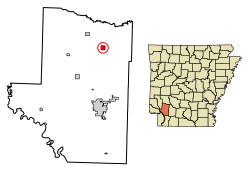Geography
Blevins is located in northeastern Hempstead County. U.S. Route 371 passes through the city as Center Street, leading southeast 15 miles (24 km) to Prescott and northwest 19 miles (31 km) to Nashville. Arkansas Highway 29 is Main Street in Blevins, crossing US 371 in the center of town and leading northeast 18 miles (29 km) to Antoine and south 15 miles (24 km) to Hope, the Hempstead County seat.
According to the United States Census Bureau, the city of Blevins has a total area of 1.0 square mile (2.6 km2), all land. [3]
Demographics
At the 2000 census, [6] there were 365 people, 131 households and 102 families residing in the city. The population density was 365.8 inhabitants per square mile (141.2/km2). There were 152 housing units at an average density of 152.4 per square mile (58.8/km2). The racial makeup of the city was 73.15% White, 14.25% Black or African American, 2.47% Native American, 7.67% from other races, and 2.47% from two or more races. 18.36% of the population were Hispanic or Latino of any race.
There were 131 households, of which 38.2% had children under the age of 18 living with them, 58.8% were married couples living together, 14.5% had a female householder with no husband present, and 22.1% were non-families. 19.8% of all households were made up of individuals, and 11.5% had someone living alone who was 65 years of age or older. The average household size was 2.79 and the average family size was 3.21.
28.2% of the population were under the age of 18, 10.7% from 18 to 24, 22.7% from 25 to 44, 24.4% from 45 to 64, and 14.0% who were 65 years of age or older. The median age was 35 years. For every 100 females, there were 102.8 males. For every 100 females age 18 and over, there were 100.0 males.
The median household income was $31,875 and the median family income was $38,750. Males had a median income of $25,313 versus $18,750 for females. The per capita income for the city was $11,720. About 19.6% of families and 22.1% of the population were below the poverty line, including 25.9% of those under age 18 and 6.9% of those age 65 or over.
This page is based on this
Wikipedia article Text is available under the
CC BY-SA 4.0 license; additional terms may apply.
Images, videos and audio are available under their respective licenses.

